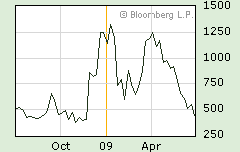 This is not your usual garden-variety recession. Because total debt in the U.S., public and private, exploded to four times GDP (a once-in-a-lifetime ratio) over the past twenty years, the unwind now underway will be protracted and brutal. As of the end of March, almost 8% of all single-family mortgages were classified as delinquent, up from 3.7% the year before and 1.6 % in March 2006. (Click on the graph above.) The problem? Too many houses--and not enough homeowner equity to justify all that construction.
This is not your usual garden-variety recession. Because total debt in the U.S., public and private, exploded to four times GDP (a once-in-a-lifetime ratio) over the past twenty years, the unwind now underway will be protracted and brutal. As of the end of March, almost 8% of all single-family mortgages were classified as delinquent, up from 3.7% the year before and 1.6 % in March 2006. (Click on the graph above.) The problem? Too many houses--and not enough homeowner equity to justify all that construction.We began 2009 with 19 million empty homes in the U.S., the most EVER. The vacancy rate stood at 2.9%, the highest since record-keeping began in 1956. Housing starts in April fell to a seasonally adjusted annual rate of 458,000, the lowest since record-keeping began in 1959. Applications for building permits, an indicator of future construction activity, fell to a seasonally adjusted annual rate of 494,000, the lowest since record-keeping began in 1960. In other words, we are seeing numbers NEVER seen before. The overhang is so huge that if all housing starts halted today, it would still take more than two years to work through the inventory at the current pace of sales.
Nationwide, 649,917 homes received at least one foreclosure-related filing in the first three months of this year--more than double the number in the year-earlier period--despite a government-whistled timeout on foreclosure activity at the nation's biggest banks. Now the grace period is up, and banks are racing to liquidate repossessed property before they go belly-up. Largely because of home-mortgage defaults, 33 banks were seized by the FDIC between New Year's Day and yesterday, resulting in a cumulative drawdown of $5.4 billion in the agency's Deposit Insurance Fund (money used to indemnify trapped depositors). Today the 34th failure was announced: BankUnited FSB, with a price tag of $4.9 billion all by itself. That leaves $8.6 billion in the DIF before the hat goes out (again) to the taxpayer.
Can the banks earn their way out of this mess? Not if the economy continues to tank, a likely outcome in light of rising interest rates. The 10-year U.S. Treasury note is fast approaching 3 1/2% (see graph below):

As one would expect in an environment of rising interest rates, applications for home loans have started to decline. According to an index compiled by the Mortgage Bankers Association (MBA), applications this week are down 14% from the week before--and 43% from the April peak. The "green shoots" represented by the refinancing spurts last winter and earlier this spring (graph below) are getting weed-whipped:
Getting back to parabolae, check out the spike (below) in the price-to-earnings ratio of the S&P 500 companies. A reversion to the mean would require either a dramatic increase in earnings or a dramatic decrease in stock prices. Which is more likely? Choose between these two answers: (A) the latter, or (B) definitely the latter.

[update, 05-28-09:]
More data were released today by the MBA in its quarterly National Delinquency Survey, which found that 9.12% of all residential mortgages in the first quarter were delinquent (at least one payment past due), the highest level since the data series began in 1979. Add to that another 3.85% that were somewhere in the foreclosure process, and you've got 1 in 8 loans in trouble. Homes entering the foreclosure process rose from Q4's 1.08% to a record 1.37%.






No comments:
Post a Comment